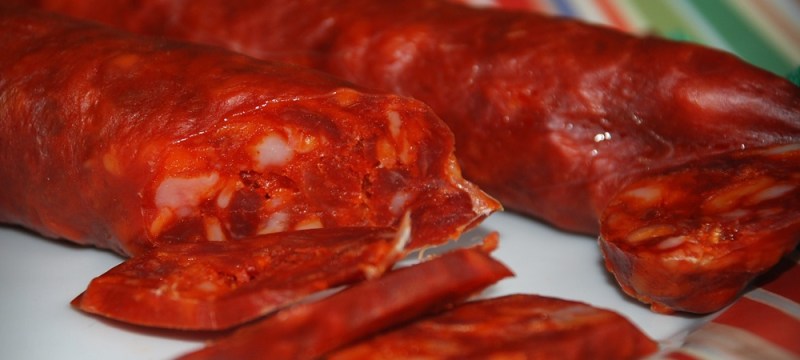Chorizo is a spicy sausage that originates from Spain and Portugal, and is also very popular in Mexico. This rich and flavorful sausage is made from a fatty meat, seasoned with many spices that vary depending on the region its made in and marinated in vinegar or wine before being cured, smoked or stuffed in a casing. Chorizo comes as a dried or fresh meat and in mild or spicy varieties. Most chorizo has a deep red color, but it can also appear green due to the use of green chiles, cilantro or spinach.
Mexican Chorizo

Mexican chorizo is one of the more common forms of chorizo. It is a fresh, raw sausage made from ground pork or beef and is generally seasoned with lots of garlic, ancho chili peppers, chili powder, paprika, oregano and cumin. Apple cider vinegar or white wine is added to the seasoned sausage that is then set aside to marinate for a lengthy amount of time. The sausage mixture is then stuffed inside a casing, but is later removed from the casing and cooked in a pan on a stovetop to eat.
Spanish Chorizo

Spanish chorizo differs from Mexican chorizo in that it is dried, cured and sometimes smoked. Because of this, it’s ready to eat when purchased, similar to pepperoni or salami. The main seasoning in Spanish chorizo is smoked paprika, which also gives it the vibrant red color. Many of the other seasonings are the same as those used in Mexican chorizo but tend to be milder in heat. Spanish chorizo also tends to be fattier.
Portuguese Chorizo
Portuguese chorizo is similar to Spanish chorizo, though the correct spelling is “chourico” and the pronunciation is different. It is fatty ground pork that is seasoned, cured and smoked after marinating in vinegar or wine. Typical seasonings of chourico include a lot of garlic, paprika, red pepper and bay. It can vary in heat intensity and be adjusted to taste either sweet or spicy. Portuguese chourico is alsoclosely related to linguica, which is a highly seasoned ground pork, but with slightly different seasonings.
Chorizo Alternatives
Chorizo usually requires the meat to be fatty and the seasonings to be strong.While chorizo usually uses pork, it can be made with other meats such as beef, boar, bison or turkey. Vegetarians can indulge in chorizo made from soy or textured protein, which can be used in similar ways to the meat version.
How To Cook With Chorizo
Chorizo’s spicy and tangy flavor makes it a great addition to many dishes. Check out some recommended foods to experiment with:
Breakfast

Chorizo makes a great breakfast meat in lieu of traditional bacon or ham — try cooking Mexican chorizo in a pan on the stove and mix the crumbled meat with scrambled eggs, diced onions and peppers for a spicy breakfast dish, or toss browned chorizo into an omelet. For vegetarians and vegans, try adding an alternative chorizo to diced potatoes, onions, peppers and mushrooms to create a breakfast hash. Cooked chorizo can also be placed on top of toast with scrambled eggs for an easy breakfast dish.
Lunch
Cooked Mexican chorizo makes a great filling for pita bread, lettuce wraps or taco shells that you can garnish with cheese, salsa and an assortment of diced vegetables. Mexican chorizo can also serve as the beef substitute to make a Sloppy Joe sandwich. If you buy smaller Spanish chorizo sausages, they can be used as hot dog meat — top them with caramelized onions, diced tomatoes and jalapeños for extra spicy flavor.
Dinner

Mexican chorizo can serve as a great replacement for ground beef in almost all dinner dishes — it can be cooked into a delicious bolognese sauce to serve over pasta or as the meat in a nice bowl of chili. Spanish chorizo can be a great cured meat to place alongside a cheese board, and also tastes delicious chopped up and served in a stir-fry.
